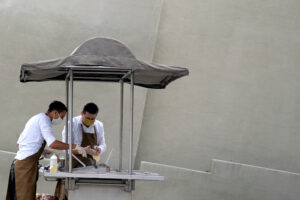Useful Tips For Caring For Your Japanese Knife

A Japanese Kiritsuke knife will function well when taken good care of. You should know when and how to sharpen your knife, how to clean it and store it. Without proper care, your knife will get blunt, chip and even break due to carelessness. Here are some tips to care for your knife.
Honing your knife is very important
Just because your knife is not cutting cleanly does not mean it is not sharp. Maybe it is due to the misalignment of the sharp edge. The best thing to do is to ensure the edge is in line. Misalignment of the edge can happen when you cut over a hard surface such as a stone or a metallic lid. Doing so will bend the sharp edge of the knife to one side. This could lead to accidents since the knife can easily slide and cut you. You should use honing steel to fix a rolled edge.
Apply more pressure when sharpening
Some people get worried that they will crack or break the knife when sharpening so they fail to apply more pressure. When you do not apply adequate pressure, your knife will not be sharpened well. You should apply up to six pounds of pressure to a sharp knife but if the knife is dull then you should apply up to eight pounds.
Whetstones aren’t one type fits all
If you are new to whetstones, you may think that any whetstone is effective for your knife. But when you buy Kiritsuke knife, it is important to inquire about the right whetstone to use for your knife. Lower grits have a more textured surface area. They can be used to reshape knives and fix chips. They can be used to shave off most material. On the other hand, higher grits are the best for basic sharpening and polishing. If you are going to buy one stone then this would be a good choice. If you want a stone to smoothen and polish your edge then you should consider the highest-grade stones.
When it comes to sharpening knives, it is best to use multiple whetstones and work up from higher to lower coarseness in the same way you might use rough sandpapers to smooth out the wood and finer sandpapers to polish your wood. Pieces of leather are sometimes used to give a fine polish to the edge of the blade.
Be wary of the angle at which you sharpen your Japanese knife
Professional chefs maintain their Japanese knives using specific degrees for sharpening their knives for specific tasks. For example, if you are splitting chicken, 20 degrees per side will give you more strength. On the other hand, if you are cutting cucumbers, you should consider 10 degrees per side to make it slick and efficient.
If you are just starting out with your Japanese Kiritsuke knife Australia, the best would be to maintain an angle between ten to fifteen degrees. If you are not sure what this looks like then you should lay your knife on the whetstone and put a matchbook under the blade and remove the matchbook to keep the angle. This will be fifteen degrees.




